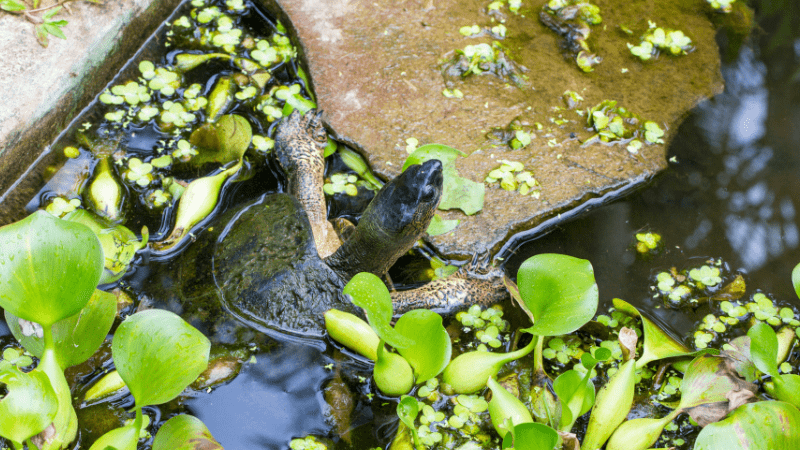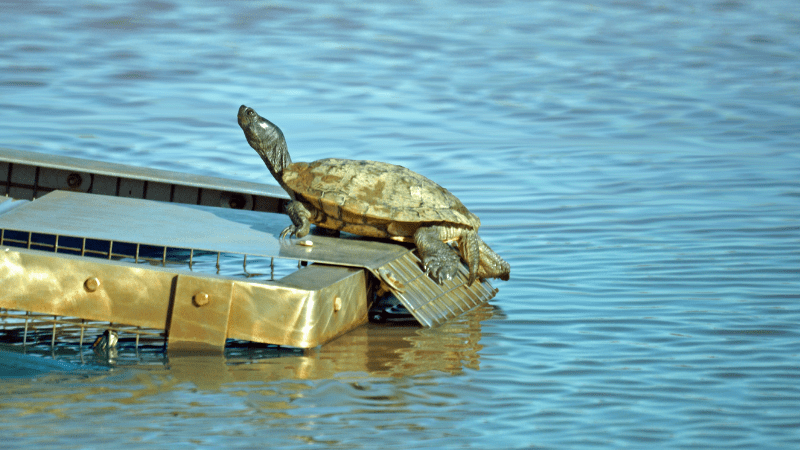How to Get Rid of Turtles in a Pond (Best Methods)
Pond Academy is reader-supported. Buying through links on our site may earn us an affiliate commission. As an Amazon Associate I earn from qualifying purchases.
Turtles are cute and can be a pleasant surprise in your pond.
They can also be a real nuisance, however, wreaking havoc in more ways than one.
If turtles fall in the latter group for you, then you'll need an effective way to remove them from your pond.
So, let's learn how to get rid of turtles in a pond and keep them from coming back.
Is It Bad to Have Turtles in Your Pond?

Most turtle species are harmless to ponds and, in some cases, may be beneficial to your pond's ecosystem. In most cases, I advise pond owners to leave them be.
Before you invest the time and money in removal, let's quickly run down the pros and cons of having turtles in your pond.
The Pros of Turtles in Your Pond
- Turtles have an important role in the ecosystem and play a part in ecological balance. They are omnivorous and eat dead animal and plant matter as well as sick or weakened fish, contributing to improved water quality. Even the snapping turtle will mainly eat sick or dead fish over healthy live ones.
- Turtles typically don't create any biological issues in a pond. They might eat the same food as your fish (insects, etc.), and some turtles, primarily snappers, will sometimes prey on live fish. However, their effect on your pond is minimal.
- They are a cute and fun addition to your pond!
The Cons of Turtles in Your Pond
- The main issue people have with turtles is that they reproduce quickly and can overpopulate a small pond in just a few years, leading to pond water quality issues.
- There is the chance that some turtle species will eat live fish, which can be an issue if you have a pond with ornamental fish like goldfish or koi. They will also eat any aquatic plants you have in your pond. See What Do Pond Turtles Eat? for more information on a turtles diet.
- If you have snapping turtles, they can be very aggressive if provoked, even if unintentional. And their bites can cause serious injury to those in or near your pond.
- Turtles can also transmit diseases to humans, such as salmonella. If you experience stomach issues (abdominal cramps, nausea, vomiting, etc.) after coming into contact with a turtle, you should seek medical attention immediately.
![]() Tip
Tip
Check out our guide Turtles in a Pond: Good or Bad? for more information on the pros and cons of pond turtles.
Again, in most cases, it's fine and even beneficial to let the turtles be. But, there are some circumstances where turtles become pests and must be controlled. Let's learn how to do that properly.
Get Our Best Pond Tips Sent to Your Inbox for Free!
Join thousands of others and learn from our decades of pond building and maintenance experience! Your pond will thank you!
By subscribing you agree to receive emails from PondAcademy.com. We will always respect your privacy and you can unsubscribe at any time.
How to Get Rid Of Turtles in a Pond

There are several different ways to get rid of turtles in a pond. The best way for you will depend on the size of your pond, the number of turtles you're trying to remove, and the amount of time you want to invest in their removal.
There are also two different aspects you need to take into account when ridding your pond of turtles:
- Removing the turtles
- Relocating the turtles
Let's first look at the different ways to catch and remove the turtles, your options for relocating them, and some important information you should know.
Trapping Turtles
The most efficient method of removing turtles from a pond is trapping them, especially if you have a large farm pond or lake and/or many turtles to remove.
The type of turtle trap you use will depend on the type of pond turtles you're dealing with. You'll have two main options for traps - submerged turtle traps and floating turtle traps.
Submerged Turtle Traps
Submerged traps are most effective for snapping turtles and soft-shell turtles.
Floating Turtle Traps
Floating traps are effective for red-eared sliders and other turtles that like to lay in the sun.
You'll want to bait your trap with small fish (like minnows) or fresh meat. Replace the bait every couple of days.
Manual Removal
If you have a smaller backyard pond or just one or two turtles to remove from a medium-sized pond, then manually catching them with a net may be your best, most cost-effective option.
To do this, you can use a telescoping pond net and scoop the turtles out of the water or push them into the net while they are sunbathing.
![]() IMPORTANT
IMPORTANT
Do not try to pick up a turtle and place it in the net with your bare hands. Snappers have a painful bite, and other turtles can carry and transmit diseases such as salmonella.
Other Turtle Removal Methods
- Hook & Line: Using a dropline with a hook is an effective, albeit time-consuming, method to catch turtles in a pond. If you have fish, you can protect the bait from them by using a soft drink can. First, use a can opener to remove the top. Then, punch a small hole in the bottom of the can. Run the fishing line through the can with the large open end facing down. Attach a treble hook to your line and bait the hook with pieces of fish or meat. Tie the string or fishing line to a pole, tree, or root and drop the hook in the water. You'll want the hook just below the water surface for catching slider turtles. And completely submerged for snapping or soft-shelled turtles.
- Shooting Turtles in a Pond: This method is absolutely not recommended for obvious reasons. Plus, some turtle species are protected, and killing them may be against the law.
Relocating Turtles
Once you've caught the turtles in your pond, it's time to properly relocate them.
Unfortunately, this isn't as easy as just driving over to a local creek and dumping the turtle there.
First, you will want to contact your local conservation office or the Department of Wildlife and let them know your plans to relocate the turtles. You may need a permit to relocate the nuisance animals, depending on the state you live in.
Second, relocating turtles can have serious consequences:
- Turtles can get frightened and confused when they are suddenly relocated to a new environment. They may have trouble finding food and safety from predators.
- Introducing new turtles to a specific location may result in competition over food resources, especially if other turtles already live there.
- As well, you may unknowingly spread diseases from one turtle population to the next.
Relocating turtles is a viable option, but it's best to talk to a professional at your local conservation office before attempting to relocate them yourself. They may have experience with this sort of thing and should be able to help you give your turtles a new home.
How to Keep Turtles Away From a Pond
Once you get rid of the turtles in your pond and relocate them, you'll want to make sure they don't keep coming back.
The only real way to effectively keep turtles away from your pond is to barricade them out. You can do this a few different ways:
- Yard Fence: You can keep turtles out of your yard and pond by putting up a fence around your property. This may also help keep other predators away from your pond, as well. While this may be effective at repelling turtles, it can be costly and may not even be an option within certain neighborhoods.
- Perimeter Fence: A fence around the perimeter of your pond can also effectively keep turtles out of your pond. A small, 1-2 foot high barrier around your pond may help prevent turtles from gaining access. This option is cheaper than building a fence around your entire yard, but it may ruin the aesthetic value of your pond.
- Pond Netting: Placing mesh pond netting over your pond is a cheap and effective way to protect it from predators, debris, and... turtles! It's arguably the cheapest option of the three and, depending on the net you use, is barely visible.








